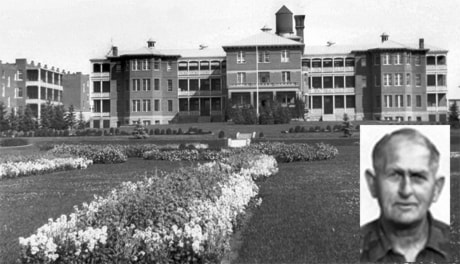Much has been written and told about the Provincial Mental Hospital (Centennial Centre) since its memorable inception near Ponoka 100 years ago. Right from the humble beginnings the expansion was rapid in all areas of the massive facility, the patient count would eventually exceed 1,000, and a first class team of doctors, nurses, medical, support, and training staff was established to administer the ongoing first class treatment, care, and growth.
Another delightful chapter of the proud history of the Alberta Hospital was their working farm, as well as acres of gardens, berry patches and a picturesque array of flowers and landscaping that surrounded the grounds, and quickly became the talk of the town and the province.
Alexander Paton was the first gardener from 1911 to 1915, followed by Joe Brian, James Urquhart, and Frank Mayled, who carried on the vigorous ‘green thumb’ tradition for 23 years. In 1923 Charles Grant took charge of the new hospital greenhouse, taking great pride in his ability to grow beautiful plants and a bountiful harvest of tomatoes. Those thousands of bedding plants were carefully put into the ground to bloom and beautify each spring, while the entire hospital always had a colourful display of potted flowers and plants around the wards, offices, and dining halls.
In 1941 a young gritty Englishman and soccer fanatic, and his wife, Orvetta, came to Ponoka. Here, Percy Mitchell would later take on the position of head gardener at the very active hospital. Growing up on the grounds, his daughter Dorothy Salter vividly remembers how much her father enjoyed his year-round chores, while her mother worked as a medical secretary for the doctors.
For many decades the head gardener was in charge of supervising staff and groups of patients in the planting, care, and harvesting of massive crops of vegetables. The tons of produce were packed into the huge root cellars for winter storage, to be later used for year round meals for patients and staff. A modern cannery was set up by J.D.J. McDonald, and with annual processing reaching 23,000 gallons of fruits and vegetables, it would supply the Ponoka Hospital as well as other provincial institutions.
Other duties of the busy garden crew included mowing lawns, trimming hedges, raking leaves, weeding, and planning future landscaping projects. In the winter there was lots of snow to move, ice to make, and maintenance at the curling and skating rinks. There was also the arduous task of cutting huge blocks of ice out of nearby Chain Lakes, then transporting them back to the ‘ice house’ to be stored and stacked for hospital use in the summer months.
Several of the milestones they completed over the years included the construction of the curling rink, the sports field, bowling green, and tennis court, as well as assisting with tree planting and landscaping for the nearby golf course. Occasionally the crew had to dispose of the hundreds of feral cats that had collected around the grounds, as well as tend to the sheep that were used to keep large patches of grass trimmed. In moderate weather, a ‘wood crew’ of five men was assigned to the bucking, splitting, and piling of firewood that was used at the hospital or sold and delivered to the staff houses. An early attempt was made at beekeeping at the hospital to provide a supply of honey to the kitchen, but it did not last long, as no one wanted to care for the hives.
The farm staff did a lot of the cultivation of the annual crops and potato production, but the garden crew tended to the small vegetable gardens and raspberry and strawberry patches. Plowing, seeding, cultivation, and digging was done by horse drawn machines, while the picking, sacking, hauling, and storage was completed by as many as 100 men from the wards who earned tobacco and afternoon lunch for their efforts.
For years around the hospital the ‘garden and snow gang’ was supervised by a big genial Irishman by the name of Dave Hourigan, who was said to have a special way with the patients, and his good nature assisted many on their way to recovery. Not that many years later, another friendly giant, Charlie Bowie, took care of the ‘garden crew’ with the same care and kindness until his retirement. Others who would serve on the garden and greenhouse staff over the years included William (Bill) Woelfing, Allister McKinnon, George Ogilvie, Emrys Evans and Eugene Stebner.
When the Alberta Hospital Ponoka became an active treatment centre in 1962, gardening on a large scale ceased but small plots were maintained as a form of therapy for the patients. The farm and cannery were closed in the early 1960s, but the greenhouse and ongoing work around the grounds remained active.
In the past couple of decades the gradual modernization and expansion has steadily changed both the inside and outside appearance of our Centennial Centre for Mental Health and Brain Injury. As they proudly prepare to celebrate their 100th anniversary this July, those same dedicated traditions of excellent patient care, treatment and facilities, as well as pristine landscaping have always remained the same.
For reunion weekend (July 29 to 31) information and registration please contact ahp100yearrenunion@gmail.com or view it at their website at http://100yearsofcaring-reunionweekend.weebly.com
